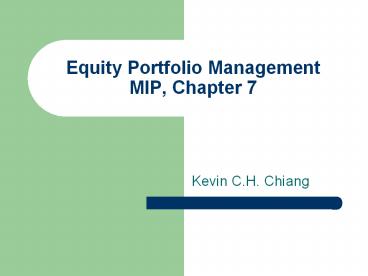Equity Portfolio Management MIP, Chapter 7 PowerPoint PPT Presentation
Title: Equity Portfolio Management MIP, Chapter 7
1
Equity Portfolio ManagementMIP, Chapter 7
- Kevin C.H. Chiang
2
Approached to equity investment
- Passive management
- The dominant approach is indexing
- Active management
- Seeks to outperform a given benchmark
- By overweighting those stocks that deem promising
and underweighting those stocks that deem less
promising
3
Active return
- Active return the differences between fund
returns and benchmark returns. - The goal of active management is try to generate
consistent positive active returns (holding other
factors constant, higher the better).
4
Tracking ratio and information ratio
- Tracking risk the standard deviation of active
returns (the lower the better). - Information ratio the ratio of mean active
return to tracking risk (the higher the better). - Some sponsors impose expectations on managers
tracking risk and information ratio.
5
Popular equity indices
- Exhibit 7-10, pp. 420-421.
6
Investment style
- Investment style a natural grouping of
investment disciplines that has some predictive
power in explaining the future dispersion of
portfolio/fund returns across portfolios/funds. - Why one particular style? (1) Drives fund risk
and fund return, (2) allows research to be more
focused, (3) aligns with research strengths and
philosophy, (4) fund/plan sponsors often requires
style specialization.
7
Value style vs. growth style
- Value style investing in high value/price (low
price/value) stocks e.g., high B/M stocks, low
P/E stocks. - A stylized value premium.
- At least 3 sub-styles low P/E, contrarian, and
high yield. - Growth style investing in low value/price (high
value/price) stocks. - The most popular style among mutual funds.
- At least 2 sub-styles consistent growth (a
long-history of sales growth, superior earnings),
and earnings momentum.
8
Big-cap style vs. small-cap style
- Used to have a small-cap premium.
- Small-cap style can impose liquidity/depth risk
on large funds.
9
Techniques for identifying styles
- 1st category return-based methods, such as
regressions or Sharpes style analysis (a special
form of regression). - An example of rolling style chart, Exhibit 7-13,
p. 439) - 2nd category holdings-based analysis.
- Look into actual stock holdings.
- Morningstar uses this method to construct its 33
style box for funds (Exhibit 7-18, p.448).
10
Style drift
- Drift inconsistency in investment style over
time. - An obstacle to investment planning and risk
management from fund/plan sponsors perspectives. - Fund/plan sponsors usually monitor for signs of
style drift managers may need to explain for it.
11
SRI
- Socially responsible investing one can consider
this to be a special style. - Some fund/plan sponsors today have an SRI
mandate. - Some fund/plan sponsors worry that an SRI mandate
will reduce diversification benefits.
12
Screening
- Screening based on some criteria reflecting
investing style and philosophy, e.g., P/E,
earnings momentum, etc., is often used by
research units so that there is focus and
efficiency in research.
13
Structuring research
- Top-down focus research on macroeconomic/industri
al factors or investment themes. - The stock holdings in top-down investors
portfolios reflect their macro insights. - Bottom-up have little interest in the state of
the economy or other macro factors, but rather
try to put together the best portfolio of stocks
based on company-specific information.
14
Sell-side vs. buy-side research
- Sell-side research is generally organized by
sector/industry with a regional delineation
e.g., a U.S. banking analyst. - Buy-side research mainly concerned with
assembling a portfolio, so decisions on buy-side
research are usually made through a committee
structure. - These research reports/essays are not available
to outsiders.

